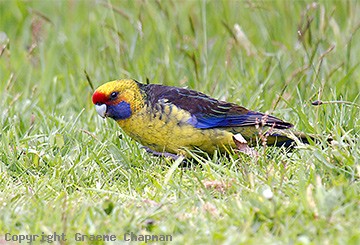
Green Rosella
[order] PSITTACIFORMES | [family] Psittacidae | [latin] Platycercus caledonicus | [authority] Gmelin, 1788 | [UK] Green Rosella | [FR] Perruche palliceps | [DE] Gelbbauch-Siitich | [ES] Perico de Tasmania | [NL] Geelbuikrosella | [copyright picture] Greame Chapman
| Genus |
Species |
subspecies |
Region |
Range |
| Platycercus |
caledonicus |
|
AU |
Tasmania |
| Platycercus |
caledonicus |
brownii |
|
King I. (Bass Strait) |
| Platycercus |
caledonicus |
caledonicus |
|
Tasmania, Flinders I. |
Genus
Rosellas are colourful parrot species belonging to the genus Platycercus. All Rosella species are native to mainland Australia or a few nearby islands and inhabit forests and farmlands. They have also managed to adapt well to life near humans and are today found in many parks and gardens. Rosella parrots only live in coastal mountains and plains and are not present in Australia?s outback region. The genus name Platycercus means broad-tailed, reflecting the broad tail seen on Rosellas and other members of the broad-tailed parrot tribe.
Male-body yellow/gold; wide red frontal band; purple/blue cheek patches; yellow/gold underparts; mantle and back soft black scalloped dull green; yellow/olive on rump and upper tail coverts; purple/blue on upper wing coverts; tail dull bronze/green widely tipped with blue/white. Bill grey/white. Eye dark brown. Female-as in male but foreneck suffused with orange/red; smaller bill.
Listen to the sound of Green Rosella
[audio:http://www.planetofbirds.com/MASTER/PSITTACIFORMES/Psittacidae/sounds/Green Rosella.mp3]
Copyright remark: Most sounds derived from xeno-canto
recorded by Macaulay Library
| wingspan min.: |
0 |
cm |
wingspan max.: |
0 |
cm |
| size min.: |
36 |
cm |
size max.: |
38 |
cm |
| incubation min.: |
19 |
days |
incubation max.: |
20 |
days |
| fledging min.: |
33 |
days |
fledging max.: |
38 |
days |
| broods: |
1 |
|
eggs min.: |
4 |
|
| |
|
|
eggs max.: |
6 |
|
Australasia : Tasmania
Occurs in variety of habitats up to 1500m (4920 ft). Lowlands, eucalypt forests, rainforest, montane forest, riverine forest, scrub, roadside hawthorns, orchards, gardens and cleared country.
Breeding of the Green Rosella is not well known. They lay their 4-6 eggs in a hollow of a trunk, limb or spout (broken dead limb) of a tree, usually an eucalypt. They may compete with Common Starlings for hollows. The nest hollow is lined with wood dust and the birds chew at the entrance to the hollow to widen it. The female may spend several weeks in the hollow before laying and she alone incubates for about 19 days, leaving the nest only to be fed by the male. Young fledge after 5 weeks.
Found in groups of 4-5 birds, with larger flocks occurring post-breeding. Will associate with the Eastern Rosella. Pairs have strong bond. Feeds on hawthorn and Coprosma berries, nectar, insects and orchard fruits. Also take grass seeds.
httpv://www.youtube.com/watch?v=Ti2I_boHXP0
copyright: Eldert Groenewoud
Although this species may have a restricted range, it is not believed to approach the thresholds for Vulnerable under the range size criterion (Extent of Occurrence <20,000 km2 combined with a declining or fluctuating range size, habitat extent/quality, or population size and a small number of locations or severe fragmentation). Despite the fact that the population trend appears to be decreasing, the decline is not believed to be sufficiently rapid to approach the thresholds for Vulnerable under the population trend criterion (>30% decline over ten years or three generations). The population size has not been quantified, but it is not believed to approach the thresholds for Vulnerable under the population size criterion (<10,000 mature individuals with a continuing decline estimated to be >10% in ten years or three generations, or with a specified population structure). For these reasons the species is evaluated as Least Concern.

Green Rosellas are mainly sedentary but may wander looking for food and water. Juveniles may gather in large flocks and wander over large areas.



